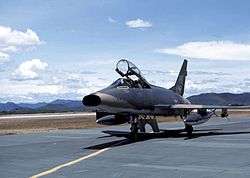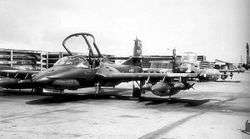Phù Cát Air Base
| Phù Cát Air Base | |
|---|---|
|
Part of South Vietnamese Air Force (VNAF) Pacific Air Forces (USAF) | |
|
Phù Cát Air Base in 1971 | |
 Phù Cát Air Base | |
| Coordinates | 13°57′18″N 109°02′32″E / 13.95500°N 109.04222°E |
| Type | Air Force Base |
| Site information | |
| Condition | Joint Civil/Military Airport |
| Site history | |
| Built | 1966 |
| Built by | US Air Force |
| In use | 1966–present |
| Battles/wars | Vietnam War |
| Airfield information | |||||||||||
|---|---|---|---|---|---|---|---|---|---|---|---|
| Summary | |||||||||||
| Elevation AMSL | 79 ft / 24 m | ||||||||||
| Runways | |||||||||||
| |||||||||||
Phù Cát Air Base (Vietnamese: Căn cứ không quân Phù Cát ) (1966–1975) was a United States Air Force (USAF) and Republic of Vietnam Air Force (VNAF) facility used during the Vietnam War (1959–1975). It is located north of the city of Qui Nhơn in southern Vietnam.
USAF use

In late 1965, with the buildup of US airpower in South Vietnam, the existing air bases were becoming overcrowded. In September, plans to build an air base at Qui Nhon were suspended when the site conditions were found to be unsuitable. In January 1966 a site in Phù Cát District 24 km north of Qui Nhon was identified.[1] In late February 1966 Military Assistance Command, Vietnam decided to build a new jet-capable base at Phù Cát.[1]:120 In April 1966 forces from the Republic of Korea Army Tiger Division secured the area for base construction, with the construction crews arriving in May. The Vietcong harassed construction with booby-traps and sniper fire killing 3 Korean soldiers.[1]:155–8
On 23 December 1966 USAF units began moving to the half-completed base. At this time the runway was a 3,000-foot (910 m) long dirt strip while the taxiways and parking areas were covered in Pierced steel planking (PSP). Nevertheless, the 459th and 537th Troop Carrier Squadrons both equipped with C-7As began operations from the base on 1 January 1967.[1]:147 Base facilities by this time included wooden barracks, a mess hall, recreation facilities and utilities.[1]:173 By late March 1967 a 10,000-foot (3,000 m) by 125-foot (38 m) asphalt runway together with sealed taxiways and parking aprons had been completed.[2] Later in the year a fuel line was constructed to the base from a tank facility on the outskirts of Qui Nhon.[2]:273
The 37th Tactical Fighter Wing (37th TFW) began operations from the base in April 1967. The 37th TFW comprised the following F-100 equipped squadrons:
- 416th Tactical Fighter Squadron (416th TFS), transferred from the 3rd Tactical Fighter Wing at Bien Hoa Air Base
- Detachment 1, 612th Tactical Fighter Squadron (612th TFS), transferred from the 35th Tactical Fighter Wing at Phan Rang Air Base[3]
While based at Phù Cát, a detachment from the 416th pioneered fast Forward Air Control (FAC) operations using two-seat F-100Fs under the code-name "Commando Sabre" and the call sign "Misty."[3][1]:265
In September 1967 a detachment from the 4th Air Commando Squadron equipped with 4 AC-47 gunships began operating from the base.[4] In September 1969 the 4th Air Commando Squadron ceased operating from the base and moved its forward operating base to Da Nang Air Base.[4]:70
On 3 February 1968 the 355th Tactical Fighter Squadron (355th TFS) was attached to the 37th TFW.[3] On 5 May 1968 the 174th Tactical Fighter Squadron (174th TFS) an Iowa Air National Guard unit equipped with F-100Cs deployed to Phù Cát AB.[5]
Detachment 13 of the 38th Air Rescue Squadron would be established at the base, renamed Detachment 13, 3rd Aerospace Rescue and Recovery Group in July 1971, it would remain there until November 1971 when it was inactivated.[6]
On 13 April 1969, Detachment 1 612th TFS left the base and was replaced by the 480th Tactical Fighter Squadron equipped with F-4Cs which moved from Da Nang AB.[3] On 11 May the 174th TFS returned to the US, followed by the 355th TFS on 15 May. On 27 May the 416th TFS transferred to Tuy Hoa Air Base and the Commando Sabre Fast FACs were inactivated.[3] On 24 June the 389th Tactical Fighter Squadron equipped with F-4Ds transferred to the base from Da Nang AB.[3] In November B Flight, 18th Special Operations Squadron (18th SOS) equipped with 3 AC-119K gunships deployed to the base where they operated primarily against supply routes in Laos.[4]:203 During 1969 40 concrete and steel "Wonderarch" aircraft shelters were constructed at the base.[2]:452

On 1 February 1970 the base was hit by a PAVN rocket attack killing one Airman and wounding 15 others.[5]:244 In March B Flight 18th SOS moved to Da Nang AB, while A Flight 17th Special Operations Squadron (17th SOS) equipped with AC-119Gs moving from Tuy Hoa Air Base replaced them at Phù Cát AB.[4]:211 On 1 April the 37th TFW was inactivated and redesignated as the 12th Tactical Fighter Wing (12th TFW).[3] In June the 459th Troop Carrier Squadron was inactivated. The 537th Troop Carrier Squadron would also be inactivated during the year with its aircraft transferred to the VNAF.[3] On 29 December A Flight 17th SOS was inactivated and its aircraft transferred to B Flight at Phan Rang AB.[4]:219
On 31 August 1971 the 361st Tactical Electronic Warfare Squadron equipped with EC-47N/Ps departed from the base.[3] On 8 October the 389th TFS flew its last combat mission and on 26 October its aircraft began returning to the US. On 20 October the 480th TFS flew its and the 12th TFW's last combat mission and on 17 November 1971 the 12th TFW was inactivated.[3] On 23 December 12 Security Police Squadron was inactivated as the VNAF took over base security. On 1 January 1972 the base was formally turned over to the VNAF.[3]
VNAF use


The 412st Transport Squadron formed at the base in 1970 operating C-7As inherited from the 537th Troop Carrier Squadron.[3]
On 17 May 1974 the base was attacked by the PAVN 2nd Regiment, 3rd Division. The attack was repulsed by the ARVN 108th and 263rd Regional Force Battalions.[7]
Capture of Phù Cát Air Base
In mid-March 1975 Qui Nhon and Phù Cát AB were defended by the ARVN 40th Regiment and the Bình Định Regional Forces, however the 40th Regiment was soon redeployed to Khanh Duong to keep open the route for ARVN escaping from Buôn Ma Thuột. The 2nd Air Division provided air support for the 22nd Division and was also trying to destroy equipment abandoned during the evacuation of Pleiku.[8]
On the morning of 30 March the Regional Forces defending the base abandoned their positions and by afternoon the base was under attack by Vietcong who were held back by the base security forces. With more Vietcong gathering for renewed attacks the base commander contacted the 92nd Air Wing at Phan Rang AB for help. The Wing commander, Colonel Le Van Thao organised a flight of 40 A-37s and they carried out a night attack on the base perimeter successfully breaking up the attack. On the morning of 31 March, the 2nd Air Division evacuated the base taking 32 aircraft, but abandoning a further 50; the PAVN/Vietcong occupied the base that afternoon.[8]:343–4
See also
Phu Cat Air Base Security Forces
References
- 1 2 3 4 5 6 Schlight, John (1999). The United States Air Force in Southeast Asia: The War in South Vietnam The Years of the Offensive 1965–1968 (PDF). Office of Air Force History. p. 87. ISBN 9780912799513.
- 1 2 3 Traas, Adrian (2007). Engineers at War. Government Printing Office. p. 274. ISBN 9780160841866.
- 1 2 3 4 5 6 7 8 9 10 11 12 Kelley, Michael (2002). Where we were in Vietnam. Hellgate Press. pp. 5–397. ISBN 978-1555716257.
- 1 2 3 4 5 Ballard, Jack (182). The United States Air Force in Southeast Asia: Development and Employment of Fixed-Wing Gunships 1962–1972 (PDF). Air Force History and Museums Program. p. 56. ISBN 9781428993648.
- 1 2 Nalty, Bernard (2000). The United States Air Force in Southeast Asia: The War in South Vietnam Air War over South Vietnam 1968–1975 (PDF). Air Force History and Museums Program. p. 45. ISBN 9781478118640.
- ↑ Tilford, Earl (1980). Search and Rescue in Southeast Asia 1961–1975. Office of Air Force History. pp. 113–4. ISBN 9781410222640.
- ↑ Dunham, George R (1990). U.S. Marines in Vietnam: The Bitter End, 1973–1975 (Marine Corps Vietnam Operational Historical Series). History and Museums Division Headquarters, U.S. Marine Corps. p. 15. ISBN 9780160264559.
- 1 2 Veith, George (2012). Black April: The fall of South Vietnam 1973–75. Encounter Books. pp. 225–7. ISBN 9781594035722.
 This article incorporates public domain material from the United States Air Force website http://www.af.mil.
This article incorporates public domain material from the United States Air Force website http://www.af.mil.
External links
| Wikimedia Commons has media related to Phù Cát Air Base. |
